lock SKODA OCTAVIA 2010 2.G / (1Z) Service Manual
[x] Cancel search | Manufacturer: SKODA, Model Year: 2010, Model line: OCTAVIA, Model: SKODA OCTAVIA 2010 2.G / (1Z)Pages: 275, PDF Size: 16.43 MB
Page 81 of 275
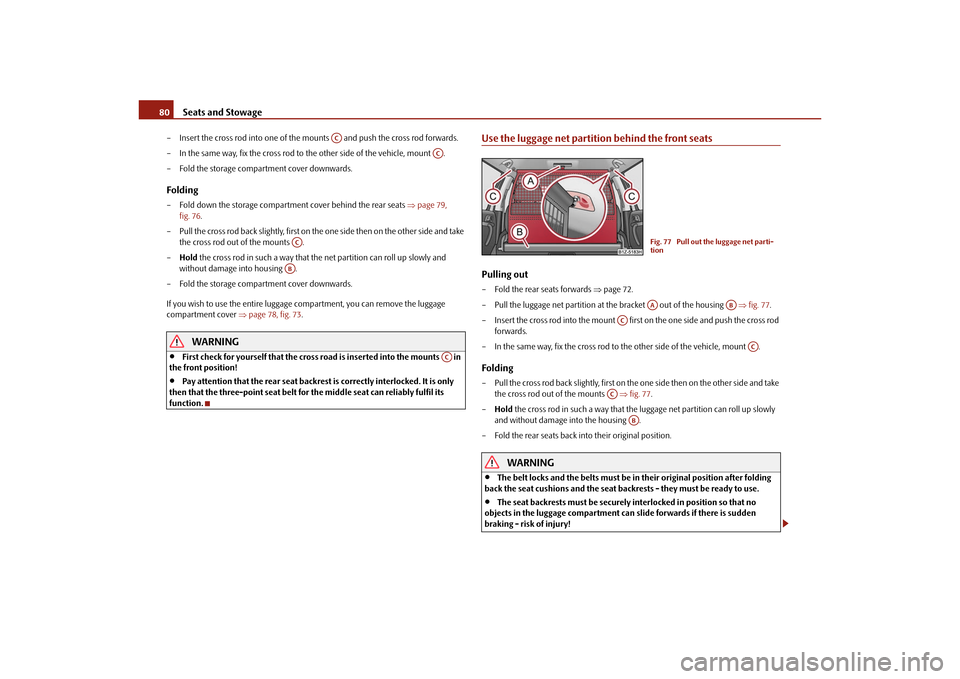
Seats and Stowage
80
– Insert the cross rod into one of the mounts and push the cross rod forwards.
– In the same way, fix the cross rod to the other side of the vehicle, mount .
– Fold the storage compartment cover downwards.Folding– Fold down the storage compartment cover behind the rear seats page 79,
fig. 76 .
– Pull the cross rod back slightly, first on th e one side then on the other side and take
the cross rod out of the mounts .
– Hold the cross rod in such a way that the net partition can roll up slowly and
without damage into housing .
– Fold the storage compartment cover downwards.
If you wish to use the entire luggage compartment, you can remove the luggage
compartment cover page 78, fig. 73 .
WARNING
First check for yourself that the cross road is inserted into the mounts in
the front position!
Pay attention that the rear seat backrest is correctly interlocked. It is only
then that the three-point seat belt for the middle seat can reliably fulfil its
function.
Use the luggage net partition behind the front seatsPulling out– Fold the rear seats forwards page 72.
– Pull the luggage net partition at the bracket out of the housing fig. 77 .
– Insert the cross rod into the mount first on the one side and push the cross rod forwards.
– In the same way, fix the cross rod to the other side of the vehicle, mount .Folding– Pull the cross rod back slightly, first on the one side then on the other side and take the cross rod out of the mounts fig. 77 .
– Hold the cross rod in such a way that the luggage net partition can roll up slowly
and without damage into the housing .
– Fold the rear seats back into their original position.
WARNING
The belt locks and the belts must be in their original position after folding
back the seat cushions and the seat backrests - they must be ready to use.
The seat backrests must be securely interlocked in position so that no
objects in the luggage compartment can slide forwards if there is sudden
braking - risk of injury!
AC
AC
ACAB
AC
Fig. 77 Pull out the luggage net parti-
tionAA
AB
AC
AC
AC
AB
s43s.1.book Page 80 Thursday, May 13, 2010 1:21 PM
Page 82 of 275
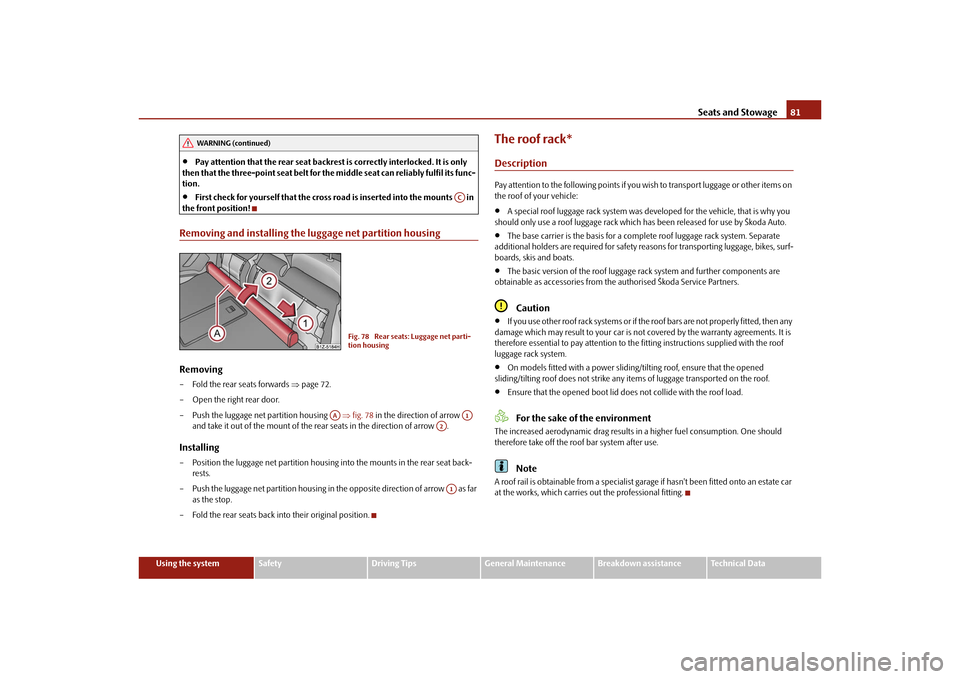
Seats and Stowage81
Using the system
Safety
Driving Tips
General Maintenance
Breakdown assistance
Technical Data
Pay attention that the rear seat backrest is correctly interlocked. It is only
then that the three-point seat belt for th e middle seat can reliably fulfil its func-
tion.
First check for yourself that the cross road is inserted into the mounts in
the front position!
Removing and installing the luggage net partition housingRemoving– Fold the rear seats forwards page 72.
– Open the right rear door.
– Push the luggage net partition housing fig. 78 in the direction of arrow
and take it out of the mount of the rear seats in the direction of arrow .Installing– Position the luggage net partition housing into the mounts in the rear seat back- rests.
– Push the luggage net partition housing in the opposite direction of arrow as far as the stop.
– Fold the rear seats back into their original position.
The roof rack*DescriptionPay attention to the following points if you wish to transport luggage or other items on
the roof of your vehicle:
A special roof luggage rack system was de veloped for the vehicle, that is why you
should only use a roof luggage rack which has been released for use by Škoda Auto.
The base carrier is the basis for a comple te roof luggage rack system. Separate
additional holders are required for safety reasons for transporting luggage, bikes, surf-
boards, skis and boats.
The basic version of the roof luggage rack system and further components are
obtainable as accessories from the authorised Škoda Service Partners.Caution
If you use other roof rack systems or if the roof bars are not properly fitted, then any
damage which may result to your car is not covered by the warranty agreements. It is
therefore essential to pay attention to the fitting instructions supplied with the roof
luggage rack system.
On models fitted with a power sliding/ tilting roof, ensure that the opened
sliding/tilting roof does not strike any items of luggage transported on the roof.
Ensure that the opened boot lid do es not collide with the roof load.For the sake of the environment
The increased aerodynamic drag results in a higher fuel consumption. One should
therefore take off the roof bar system after use.
Note
A roof rail is obtainable from a specialist garage if hasn't been fitted onto an estate car
at the works, which carries out the professional fitting.
WARNING (continued)
AC
Fig. 78 Rear seats: Luggage net parti-
tion housing
AA
A1
A2A1
s43s.1.book Page 81 Thursday, May 13, 2010 1:21 PM
Page 84 of 275

Seats and Stowage83
Using the system
Safety
Driving Tips
General Maintenance
Breakdown assistance
Technical Data
Cup holder in rear centre console*– Press on the panel in the area fig. 81 - the cup holder comes out.
– Pull the cup holder out as far as the stop.
– Adjust the cup holder by moving the locking plate .
WARNING
Do not place any hot beverages into th e cup holder while the car is moving.
The hot beverages may spill - risk of scalding!
Do not use any cups or beakers which are made of brittle material (e.g. glass,
porcelain). You might be injured by them in the event of an accident.
Note holder
The note holder is designed e.g. for attaching a car park ticket in parking areas.
The attached note has to always be removed before starting off in order not to restrict
the driver's vision.Ashtray*Front ashtrayFig. 83 Centre console: Front ashtray / remove front ashtray insertOpening ashtray– Press on the bottom part of the cover of the ashtray - refer to fig. 83 .Removing ashtray insert– Press on the ashtray insert in the area (the insert comes out) and you can take
it out.Insert ashtray insert– Insert the ashtray insert into the mount and press it in.
WARNING
Never lay flammable objects in the ashtray basin - risk of fire!
Fig. 81 Centre console at rear: Cup
holder
AA
AB
Fig. 82 Windscreen: Note holder
AA
AB
s43s.1.book Page 83 Thursday, May 13, 2010 1:21 PM
Page 90 of 275
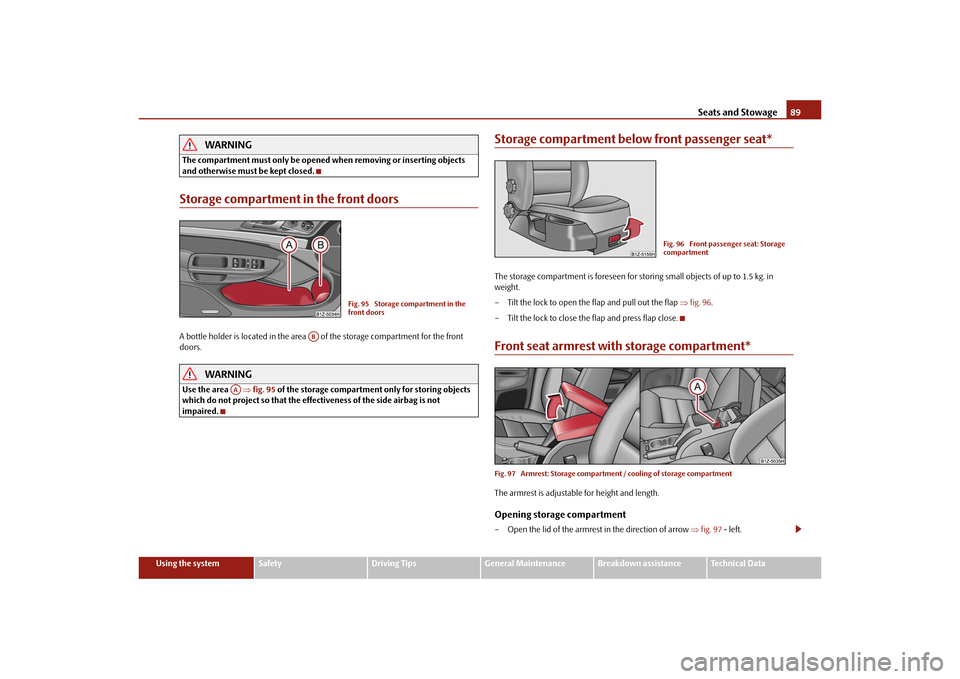
Seats and Stowage89
Using the system
Safety
Driving Tips
General Maintenance
Breakdown assistance
Technical Data
WARNING
The compartment must only be opened when removing or inserting objects
and otherwise must be kept closed.Storage compartment in the front doorsA bottle holder is located in the area of the storage compartment for the front
doors.
WARNING
Use the area fig. 95 of the storage compartment only for storing objects
which do not project so that the effectiveness of the side airbag is not
impaired.
Storage compartment below front passenger seat*The storage compartment is foreseen for storing small objects of up to 1.5 kg. in
weight.
– Tilt the lock to open the flap and pull out the flap fig. 96 .
– Tilt the lock to close the flap and press flap close.Front seat armrest with storage compartment*Fig. 97 Armrest: Storage compartment / cooling of storage compartmentThe armrest is adjustable for height and length.Opening storage compartment– Open the lid of the armrest in the direction of arrow fig. 97 - left.
Fig. 95 Storage compartment in the
front doors
AB
AA
Fig. 96 Front passenger seat: Storage
compartment
s43s.1.book Page 89 Thursday, May 13, 2010 1:21 PM
Page 91 of 275
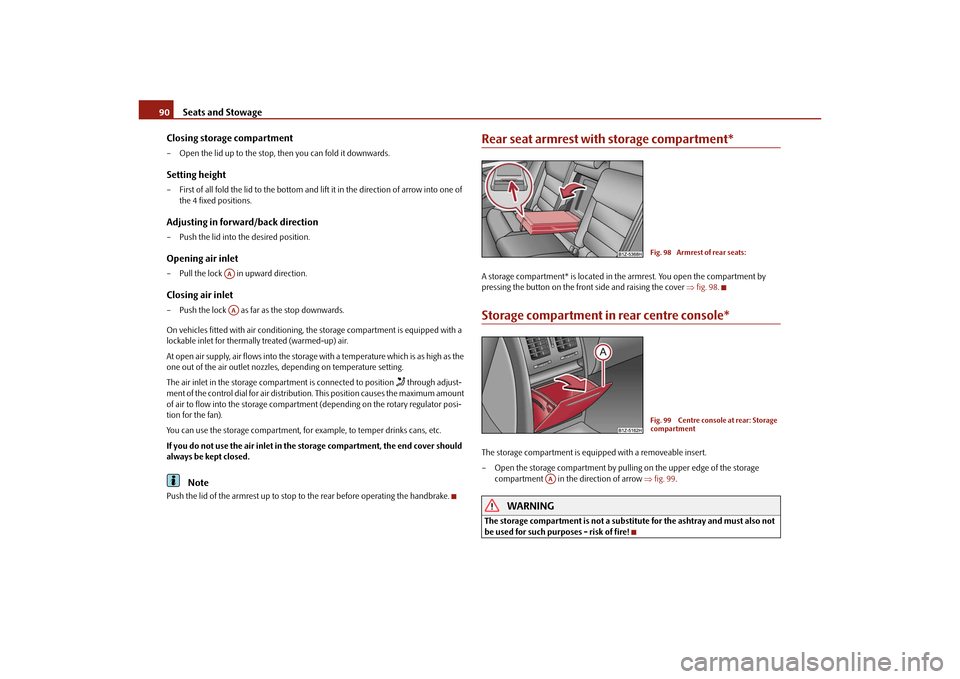
Seats and Stowage
90
Closing storage compartment
– Open the lid up to the stop, then you can fold it downwards.Setting height– First of all fold the lid to the bottom and lift it in the direction of arrow into one of the 4 fixed positions.Adjusting in forward/back direction– Push the lid into the desired position.Opening air inlet– Pull the lock in upward direction.Closing air inlet– Push the lock as far as the stop downwards.
On vehicles fitted with ai r conditioning, the storage co mpartment is equipped with a
lockable inlet for thermally treated (warmed-up) air.
At open air supply, air flows into the storag e with a temperature which is as high as the
one out of the air outlet nozzles, depending on temperature setting.
The air inlet in the storage compartment is connected to position
through adjust-
ment of the control dial for air distribution. This position causes the maximum amount
of air to flow into the storage compartmen t (depending on the rotary regulator posi-
tion for the fan).
You can use the storage compartment, for example, to temper drinks cans, etc.
If you do not use the air inlet in the storage compartment, the end cover should
always be kept closed.
Note
Push the lid of the armrest up to stop to the rear before operating the handbrake.
Rear seat armrest with storage compartment*A storage compartment* is located in the armrest. You open the compartment by
pressing the button on the front side and raising the cover fig. 98 .Storage compartment in rear centre console*The storage compartment is equipped with a removeable insert.
– Open the storage compartment by pullin g on the upper edge of the storage
compartment in the direction of arrow fig. 99 .
WARNING
The storage compartment is not a substitute for the ashtray and must also not
be used for such purposes - risk of fire!
AAAA
Fig. 98 Armrest of rear seats:Fig. 99 Centre console at rear: Storage
compartment
AA
s43s.1.book Page 90 Thursday, May 13, 2010 1:21 PM
Page 92 of 275

Seats and Stowage91
Using the system
Safety
Driving Tips
General Maintenance
Breakdown assistance
Technical Data
Seat backrest with opening for skis*Fig. 100 Rear seats: Handle of lid / luggage compartment: Unlock buttonAfter folding open the armrest and the lid, an opening in the seat backrest becomes
visible through which you can push long objects e.g. skis etc. You can fold open the
armrest and the lid from the passenger or luggage compartment.Opening from passenger compartment– Fold down the armrest of the rear seat at the loop page 73.
– Pull the handle up to the stop in upward direction and fold open the lid downwards fig. 100 - left.Opening from luggage compartment– Push the unlock button downwards fig. 100 - right and fold the lid (with armrest)
to the front.Closing– Fold the lid and the armrest up to the stop in upward direction - the lid must click into place audibly.
Ensure that the armrest is always locked into place after closing. You can recognize this
on the fact that the red field above the unlocking button of the luggage compart-
ment is not visible.
Removeable through-loading bag*The removeable through-loading bag is solely used for transporting
skis.Loading– Open the boot lid.
– Fold the rear armrest and the cover in the seat backrest downwards page 91,
“Seat backrest with opening for skis*”.
– Place the empty through-loadi ng bag in such a way that the end of the bag with the
zip lies in the boot.
– Push the skis into the through-loadi ng bag from the luggage compartment .Securing– Tighten the strap on the free end around the skis in front of the bindings
fig. 101 .
– Fold the seat backrest a little forward.
– Guide the securing strap through the op ening in the seat backrest around the
upper part of the seat backrest.
– Then push the seat backrest back into th e upright position until the locking button
clicks into place - check by pulling on the seat backrest.
– Insert the securing strap into the lock until it is heard to lock in place.
AA
Fig. 101 Securing the removeable
through-loading bag
AA
ABAB
AC
s43s.1.book Page 91 Thursday, May 13, 2010 1:21 PM
Page 93 of 275

Seats and Stowage
92
On vehicles fitted with a luggage net partition, guide the securing strap around the
housing when the net partition is rolled up . After fixing the luggage net partition in
place, it is not longer possible to unroll the luggage net partition.
WARNING
After placing skis into the through-lo ading bag, you must secure the bag
with the securing strap .
The strap must hold the skis tight.
Make sure that the strap holds the skis in front of the binding (see also
imprint on the removeable through-loading bag).Note
The through-loading bag is foreseen for four pairs of skis. The total weight of the
skis which are transported must not exceed 17 kg.
You must put the skis and the sticks in the through-loading bag with the tips facing
the rear.
If there are several pairs of skis in the th rough-loading bag, ensure that the bindings
are positioned at the same height.
Carefully fold the empty (dry) through-loading bag together, place it in the luggage
compartment and secure it to prevent it sl ipping. The through-loading bag must never
be folded together or stowed when moist.
Side compartment*
– You can open the compartment by turnin g the locks in the direction of arrow.
The CD changer* is housed in this compartment.Storage compartment behind the rear seats* (Combi)Removing– First remove the foldable luggage compartment cover page 78.
– Grasp the housing with both hands and remove it by pulling in direction of arrow fig. 103 .Installing– Push the housing up to the stop into the catch.
– Re-insert the foldable luggage compartment cover.
WARNING
Only place small and light objects up to a total weight of 3 kg into the stowage
compartment. In the event of a vehicle collision heavy objects could be thrown
out of the compartment - risk of injuries! For this reason, the front part of the
luggage compartment cover must always cover over the stowage
compartment.
AB
AB
AA
AA
Fig. 102 Luggage compartment: Side
compartment
Fig. 103 Removing the stowage
compartment
s43s.1.book Page 92 Thursday, May 13, 2010 1:21 PM
Page 106 of 275
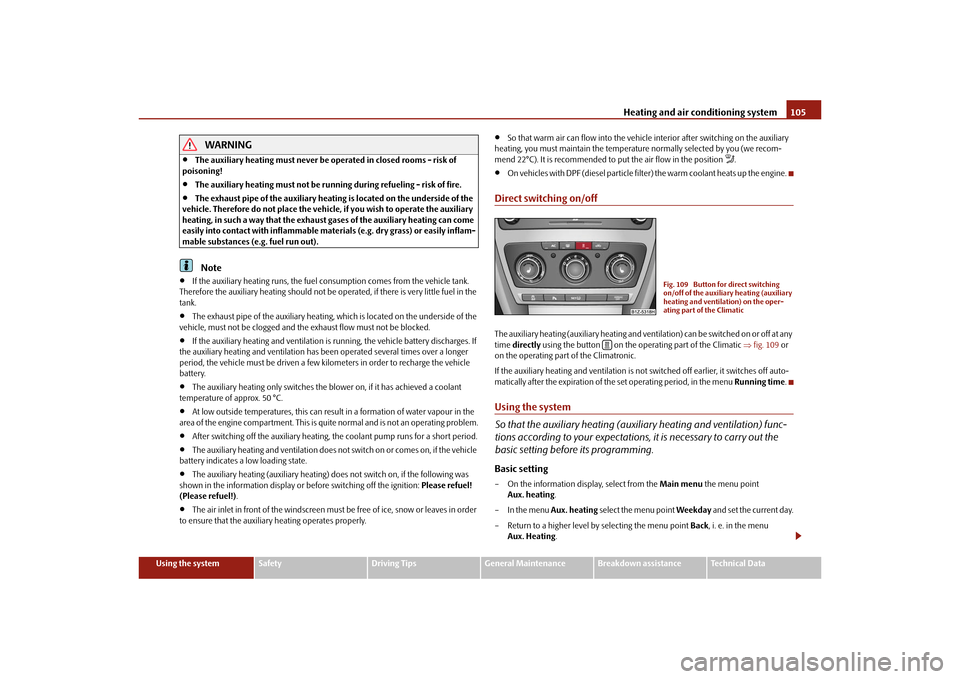
Heating and air conditioning system105
Using the system
Safety
Driving Tips
General Maintenance
Breakdown assistance
Technical Data
WARNING
The auxiliary heating must never be operated in closed rooms - risk of
poisoning!
The auxiliary heating must not be runn ing during refueling - risk of fire.
The exhaust pipe of the auxiliary heating is located on the underside of the
vehicle. Therefore do not place the vehicl e, if you wish to operate the auxiliary
heating, in such a way that the exhaust gases of the auxiliary heating can come
easily into contact with inflammable mate rials (e.g. dry grass) or easily inflam-
mable substances (e.g. fuel run out).Note
If the auxiliary heating runs, the fuel consumption comes from the vehicle tank.
Therefore the auxiliary heating should not be op erated, if there is very little fuel in the
tank.
The exhaust pipe of the auxiliary heating, which is located on the underside of the
vehicle, must not be clogged and the exhaust flow must not be blocked.
If the auxiliary heating and ventilation is running, the vehicle battery discharges. If
the auxiliary heating and ventilation has be en operated several times over a longer
period, the vehicle must be driven a few ki lometers in order to recharge the vehicle
battery.
The auxiliary heating only switches the blower on, if it has achieved a coolant
temperature of approx. 50 °C.
At low outside temperatures, this can result in a formation of water vapour in the
area of the engine compartment. This is quite normal and is not an operating problem.
After switching off the auxiliary heating, the coolant pump runs for a short period.
The auxiliary heating and ventilation does not switch on or comes on, if the vehicle
battery indicates a low loading state.
The auxiliary heating (auxiliary heating) does not switch on, if the following was
shown in the information display or before switching off the ignition: Please refuel!
(Please refuel!) .
The air inlet in front of the windscreen must be free of ice, snow or leaves in order
to ensure that the auxiliary heating operates properly.
So that warm air can flow into the vehicl e interior after switching on the auxiliary
heating, you must maintain the temperature normally selected by you (we recom-
mend 22°C). It is recommended to put the air flow in the position
.
On vehicles with DPF (diesel particle filter) the warm coolant heats up the engine.
Direct switching on/offThe auxiliary heating (auxiliary heating and vent ilation) can be switched on or off at any
time directly using the button on the operating part of the Climatic fig. 109 or
on the operating part of the Climatronic.
If the auxiliary heating and ventilation is not switched off earlier, it switches off auto-
matically after the expiration of the set operating period, in the menu Running time.Using the system
So that the auxiliary heating (auxiliary heating and ventilation) func-
tions according to your expectations, it is necessary to carry out the
basic setting before its programming.Basic setting– On the information display, select from the Main menu the menu point
Aux. heating .
– In the menu Aux. heating select the menu point Weekday and set the current day.
– Return to a higher level by selecting the menu point Back, i. e. in the menu
Aux. Heating .
Fig. 109 Button for direct switching
on/off of the auxiliary heating (auxiliary
heating and ventilation) on the oper-
ating part of the Climatic
s43s.1.book Page 105 Thursday, May 13, 2010 1:21 PM
Page 108 of 275

Starting-off and Driving107
Using the system
Safety
Driving Tips
General Maintenance
Breakdown assistance
Technical Data
Starting-off and DrivingSetting steering wheel positionFig. 110 Adjustable steering wh eel: Lever below steering columnYou can set the height and the forward/back position of the steering wheel to the
desired position.
– Adjust the driver seat page 11.
– Pull the lever below the steering wheel down fig. 110 - left .
– Set the steering wheel to the desired position (concerning height and forward/back position).
– Push the lever upwards as far as the stop.
WARNING
You must not adjust the steering wheel when the vehicle is moving!
The driver must maintain a distance of at least 25 cm to the steering wheel
fig. 110 - right. Not maintaining this minimum distance will mean that the
airbag system will not be able to properly protect you - hazard!
For safety reasons the lever must always be firmly pushed up to avoid the
steering wheel altering its po sition unintentionally when driving - risk of acci-
dent!
If you adjust the steering wheel furthe r towards the head, you will reduce
the protection offered by the driver airbag in the event of an accident. Check
that the steering wheel is aligned to the chest.
When driving, hold the steering wheel with both hands firmly on the outer
edge in the 9 o'clock and 3 o'clock po sition. Never hold the steering wheel
firmly in the 12 o'clock position or in another way (e.g. in the middle of the
steering wheel or at the inne r steering wheel edge). In such cases, injuries to the
arms, the hands and the head can occur when the driver airbag is deployed.
Ignition lockPetrol engines
- ignition switched off, engine off, the steering can be locked.
- ignition switched on
- start engine
Diesel engines - interruption of fuel supply, ignition swit ched off, engine off, the steering can be
locked.
- heating glow plugs on, ignition switched on
WARNING (continued)
Fig. 111 Ignition lock positions
A1A2A3A1A2
s43s.1.book Page 107 Thursday, May 13, 2010 1:21 PM
Page 109 of 275
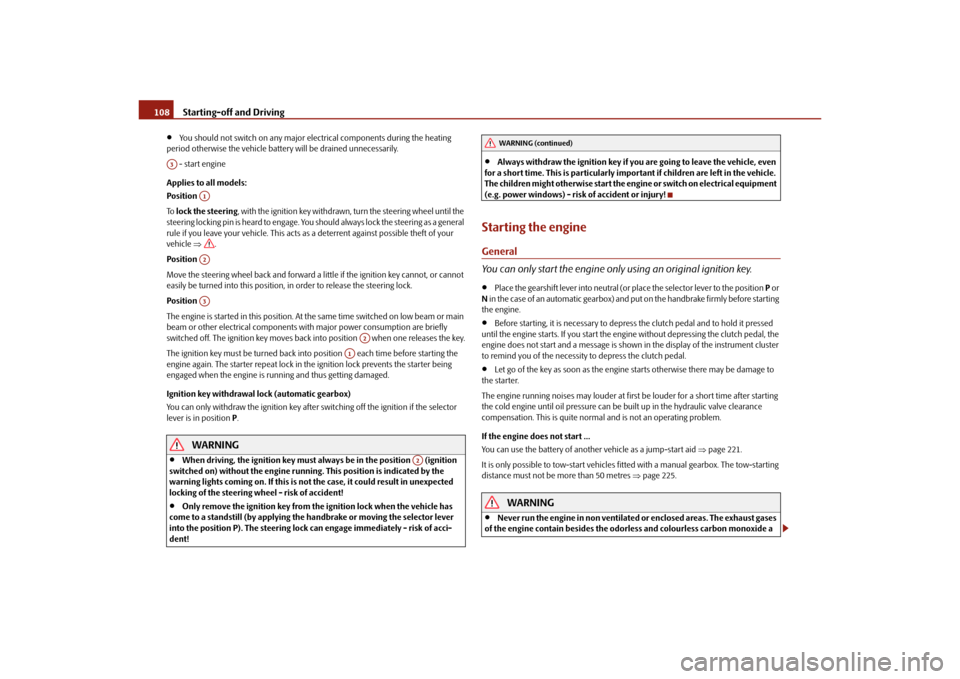
Starting-off and Driving
108
You should not switch on any major elec trical components during the heating
period otherwise the vehicle battery will be drained unnecessarily.
- start engine
Applies to all models:
Position
To lock the steering , with the ignition key withdrawn, turn the steering wheel until the
steering locking pin is heard to engage. You should always lock the steering as a general
rule if you leave your vehicle. This acts as a deterrent against possible theft of your
vehicle .
Position
Move the steering wheel back and forward a little if the ignition key cannot, or cannot
easily be turned into this position, in order to release the steering lock.
Position
The engine is started in this position. At th e same time switched on low beam or main
beam or other electrical components wi th major power consumption are briefly
switched off. The ignition key moves back into position when one releases the key.
The ignition key must be turned back into position each time before starting the
engine again. The starter repeat lock in th e ignition lock prevents the starter being
engaged when the engine is r unning and thus getting damaged.
Ignition key withdrawal lock (automatic gearbox)
You can only withdraw the ignition key after switching off the ignition if the selector
lever is in position P.
WARNING
When driving, the ignition key must always be in the position (ignition
switched on) without the engine running. This position is indicated by the
warning lights coming on. If this is not the case, it could result in unexpected
locking of the steering wh eel - risk of accident!
Only remove the ignition key from the ignition lock when the vehicle has
come to a standstill (by applying the handbrake or moving the selector lever
into the position P). The steering lock can engage imme diately - risk of acci-
dent!
Always withdraw the ignition key if you are going to leave the vehicle, even
for a short time. This is particularly important if children are left in the vehicle.
The children might otherwise start the engi ne or switch on electrical equipment
(e.g. power windows) - risk of accident or injury!
Starting the engineGeneral
You can only start the engine only using an original ignition key.
Place the gearshift lever into neutral (or place the selector lever to the position P or
N in the case of an automatic gearbox) and put on the handbrake firmly before starting
the engine.
Before starting, it is necessary to depres s the clutch pedal and to hold it pressed
until the engine starts. If you start the engi ne without depressing the clutch pedal, the
engine does not start and a message is shown in the display of the instrument cluster
to remind you of th e necessity to depress the clutch pedal.
Let go of the key as soon as the engine starts otherwise there may be damage to
the starter.
The engine running noises may louder at first be louder for a short time after starting
the cold engine until oil pressure can be built up in the hydraulic valve clearance
compensation. This is quite normal and is not an operating problem.
If the engine does not start ...
You can use the battery of anothe r vehicle as a jump-start aid page 221.
It is only possible to tow-start vehicles fi tted with a manual gearbox. The tow-starting
distance must not be more than 50 metres page 225.
WARNING
Never run the engine in non ventilated or enclosed areas. The exhaust gases
of the engine contain besides the odorless and colourless carbon monoxide a
A3
A1A2A3
A2
A1
A2
WARNING (continued)
s43s.1.book Page 108 Thursday, May 13, 2010 1:21 PM